Exclusive: Zappos Is Looking Beyond E-Commerce to Ensure It Lasts for 1,000 Years

“Maybe we’ll be in space?”
Ask Zappos employees what the future holds for the e-commerce pioneer and (aside from the long-rumored airline or a trip to Mars), they struggle to craft a clear vision for the next decade — or even the next five years.
More from Footwear News
In their defense, today’s retail landscape is in constant upheaval, and it has changed dramatically in the two decades since entrepreneur Nick Swinmurn went shopping for Airwalk sneakers and got the idea to sell shoes on the internet.
Even just 10 years ago, less than 4% of U.S. retail sales were online, according to the Commerce Department. But each year, that number has grown steadily, reaching 9.7% at the end of 2018, with digital sales totaling $513.6 billion.
Meanwhile, the number of competitors in the e-commerce space has ballooned as well, including pure-play dot-coms, traditional brick-and-mortar retailers that are catching up with their online operations and now digital-native brands, which are forgoing wholesale entirely to sell directly to the consumer.
For Zappos, that presents a serious challenge as the company envisions the path forward for its next two decades. But while other companies might find drastic change daunting, the Las Vegas-based e-tailer is uniquely experienced in that particular area.

Patrick Gray
“When I first interviewed at Zappos 13 years ago, one of the directors said to me: The only thing that’s constant at Zappos is change, and that’s very much true,” said longtime buyer Karrie Meiklereid.
Indeed, seismic shifts are underway internally at the firm that could lead it into territory beyond its roots as an e-commerce trailblazer.
“A lot of our growth and innovation moving forward will be based on thinking about what we’re in the business of differently,” said CEO Tony Hsieh. “We used to say we’re a service company that just happens to sell shoes, and now it’s turned into: We’re a service company that just happens to sell blank.”
But if you think that “blank” just means more products on its website, you haven’t been paying attention to Hsieh and his ability to make visionary ideas take shape.
In the Beginning
The Zappos origin story is familiar to many — Hsieh has shared it in his speaking engagements and in the pages of his New York Times best-seller, “Delivering Happiness: A Path to Profits, Passion, and Purpose.” And the 100,000-plus visitors who have toured Zappos’ headquarters have been regaled with the tale of a fateful phone call.
After Swinmurn latched onto the idea of selling shoes online, he left a voicemail with Hsieh’s San Francisco venture capital fund, Venture Frogs, hooking him with one factoid: “It was the fact that 5 percent of a $40 billion shoe business was already being done through mail order,” Swinmurn told FN during a 2009 interview. “That was my big statistic. People were already buying shoes without trying them on.”
Then, after another call to the Nordstrom department store in San Francisco Centre, buyer Fred Mossler eventually jumped on board, and together with Swinmurn and Hsieh, they began building one of the most original, most innovative and most successful shoe retail operations in modern history.
Reflecting on those early days, Mossler recalled that the environment was ripe for risk-taking. “You could see the internet was going to be the wave of the future, so if you were in San Francisco at that time and didn’t have an internet idea or bug, then you were probably living under a rock,” he said.
However, he had no inkling of what Zappos would become. “I never thought big enough,” he said. “It’s exceeded my wildest dreams about how successful and large it’s become.”
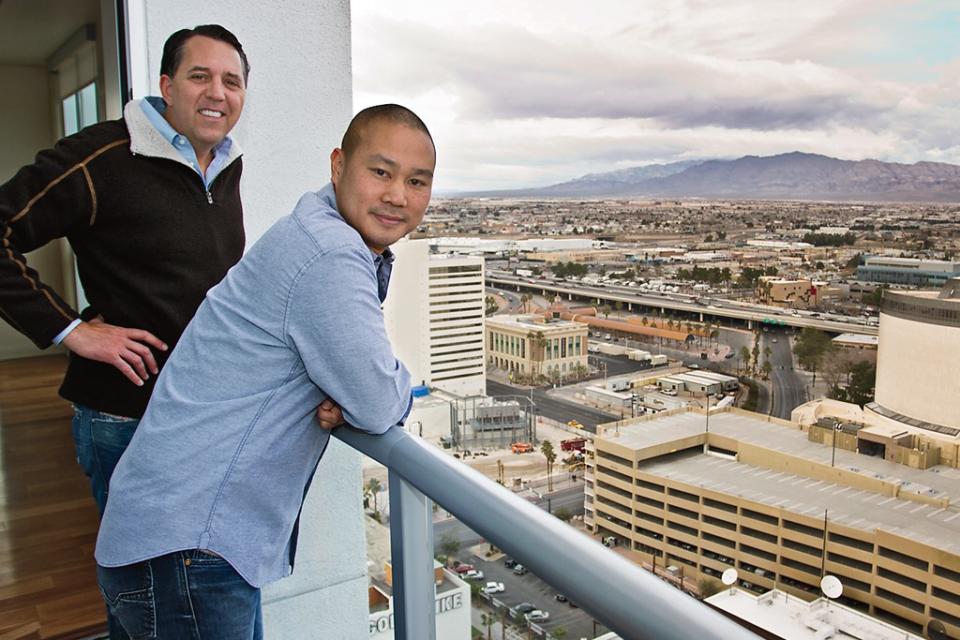
Courtesy
In its early days, the e-tailer focused mainly on volume and offering the largest selection of shoes. But under the leadership of Hsieh (who took over as CEO in 2002), Zappos turned customer service into its guiding ethos.
Mike Normart, senior director of women’s footwear, credits that, in part, to the makeup of its early merchandising team. “Half of our buyers had come from Nordstrom, so we had this customer mindset ingrained in us.”
In keeping with that focus, the e-tailer abandoned its drop-ship business in 2003, which made up roughly 25% of sales.
Hsieh considers that to be one of the company’s first big turning points: “We wanted to control the customer experience and decided we would rather give up that additional short-term revenue if it was the best long-term decision.”
Landmark Decisions
Another major shift came in 2009, when Zappos was acquired by online behemoth Amazon.com Inc. for 10 million shares of Amazon stock, which, at the time of the closing, Hsieh said was worth roughly $1.2 billion.
While many market watchers celebrated the union, they also speculated that the new parent could impose its own culture on the new division. But true to the initial agreement, Zappos has continued to operate separately from Amazon, maintaining its own leadership team and unique character. (The one area of overlap is fulfillment, as Amazon took over Zappos’ warehouse operations in 2012.)
“When we were acquired, we had five acquisition tenets anchoring around us being able to operate independently, and Amazon has done an amazing job upholding those,” said Scott Schaefer, Zappos’ GM of finance. “On a rare number of occasions that there are press points, we have good, hard conversations about what we believe is the right direction for our business. They act as our board of directors, so we’re in a position where we present to them our results each quarter and get feedback.”
He added that any cultural changes that have occurred have been driven by the internal Zappos team rather than by external parties.

Patrick Gray
The most notable such evolution came in 2015, when the company did away with managers in favor of a form of self-organization called holacracy.
In a blog post at the time, Hsieh wrote, “Like all the bold steps we’ve done in the past, it feels a little scary, but it also feels like exactly the type of thing that only a company such as Zappos would dare to attempt at this scale.”
As part of that move, at least 18% of employees opted to take a buyout package. Among the departures was Mossler, who left to focus on other businesses, including the Downtown Project, a local development enterprise that he and Hsieh created.
Those who remained have helped to form a flat system that structures employees into circles. Currently, the company consists of more than 300 such circles, directed by “lead-links” who provide goals and priorities to members.
The transition hasn’t always been easy, admitted Christa Foley, senior director of brand vision and culture. “Holacracy has been a big exercise in getting comfortable with experimentation and trying and reiterating and then backing up and going forward again,” she said, “though that’s part of our DNA and our values already.”
But now, after four years, the system’s architects say holacracy hasn’t gone far enough. “Our circles were still arranged hierarchically, where budgeting or head count was allocated from the top down,” said Hsieh. So aggressive next steps are in the works.
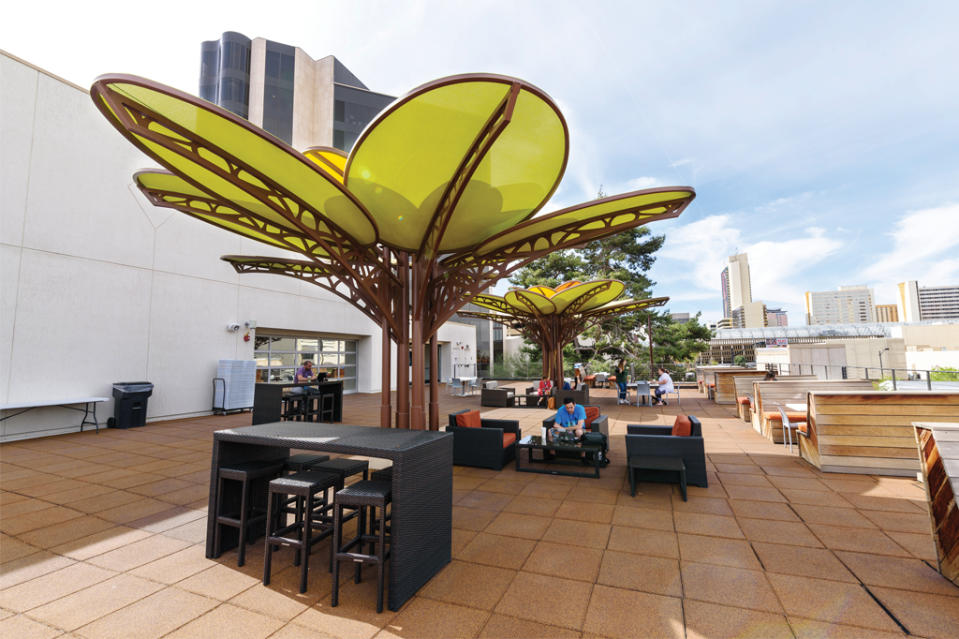
Patrick Gray
A Real-World Market
Since its early days, Zappos has functioned as something of an incubator for testing theories about corporate culture and productivity — long before those ideas became the buzzwords they are today. Much of the credit for that lies with Hsieh.
Burned from the experience with his first company, LinkExchange, which grew large and impersonal, the CEO has used Zappos as a platform to champion connectedness and employee relationships, and looked for ways to bring happiness into the workplace.
Hsieh’s latest vision for the organization is to build off holacracy and turn Zappos into a marketplace of small businesses that will operate independently, share information freely and propel the company into untapped revenue streams.
“Instead of 300 circles arranged hierarchically, we’re transitioning so that each circle is its own small business or startup,” said Hsieh, adding that each circle manages its own budget and can determine the services it will provide. Its customers can be other circles within the Zappos family — or even outside clients.
“Let’s say you’re a cupcake bakery and you want to put up a website or have a presence on social media, but that’s not your strength or passion,” Hsieh said. “Then you could potentially hire Zappos for social media or website services. That frees you up to focus on what you’re passionate about and differentiates your business.”
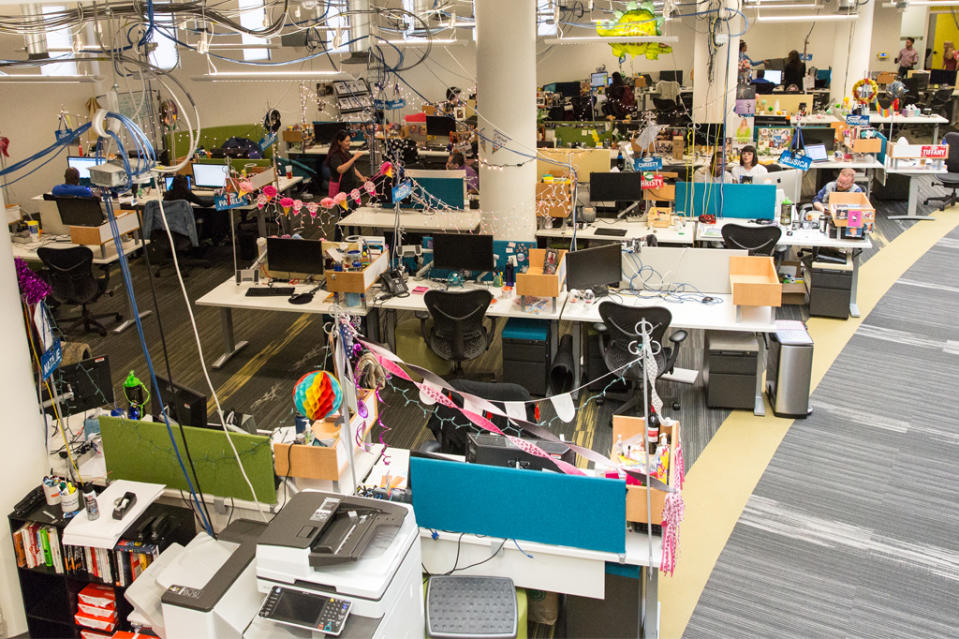
Courtesy of Zappos
John Bunch, the company’s lead organizational designer, acknowledged that this is a big change in mindset. “It’s not the typical way that most companies are operated,” he said. “At the same time, all we’re trying to do is replicate how things work in the outside world. There are businesses in the outside world that operate this way — now we just have to think of each circle operating that way.”
Already, the market-based system is in place in certain parts of the company. Tyler Williams, director of brand experience, recalled approaching the Zappos events group recently about a task but was told it was booked out for three weeks — unless he was willing to pay more.
“In the past, it would’ve been ‘do this’ and they would’ve done it, but now they have other customers, and I had to get in line just like anyone else,” said Williams. “It sounds small, but all of those little shifts in mindset and people diversifying and caring about their businesses and customers makes a huge impact at large.”
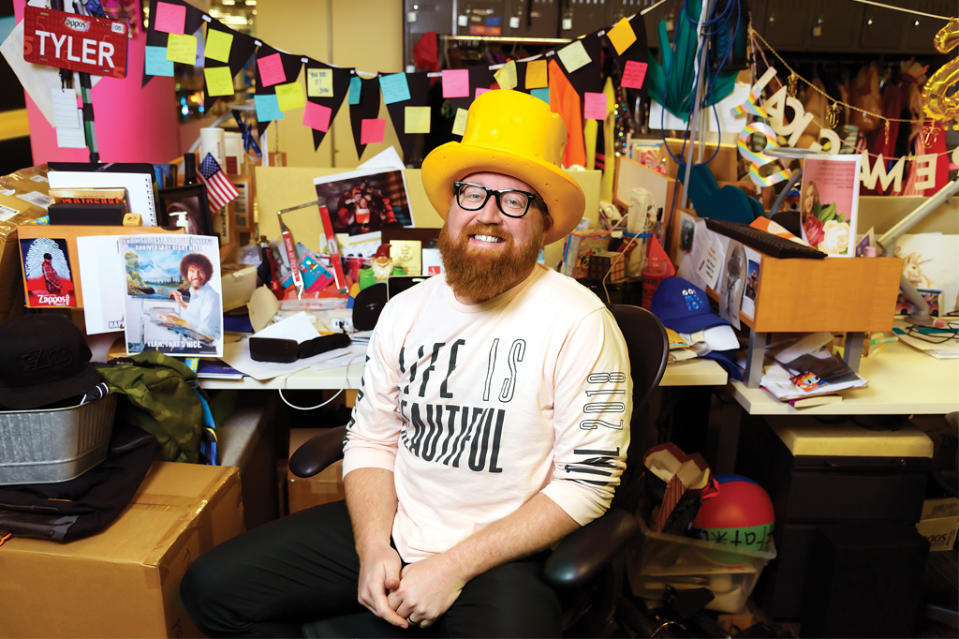
Patrick Gray
Ultimately, Zappos aims to be more nimble and increasingly innovative by empowering employees.
“The directive we give each circle is that as long as it’s in line with our culture, core values and our purpose, and as long as you can balance your own budget, then you can literally do whatever the hell you want,” said Hsieh.
People Matter
Through all the growth and change, some constants have remained at Zappos. It still holds fast in its dedication to customer service and to its crowdsourced “10 Core Values.”
Employees say that every decision they make remains rooted in those tenets. In fact, the company’s security badges come in 10 different colors, each representing a different core value that people select as their personal mantra.
And its tight-knit company culture continues to be its most valuable asset, according to team members.
“What’s been most special about Zappos is the people that I get to come to work with,” said Jeanne Markel, adviser to the CEO. “It’ll sound corny, but I really do spend most of my waking hours with Zapponians on the weekends and on trips.”
She’s not alone. The company’s collegial spirit extends well beyond the walls of the headquarters. As part of his downtown revitalization project, for instance, Hsieh has built the communal Airstream Park near Fremont Street, where he lives alongside other Zappos team members, plus numerous dogs, a 5-year-old alpaca and a sloth.
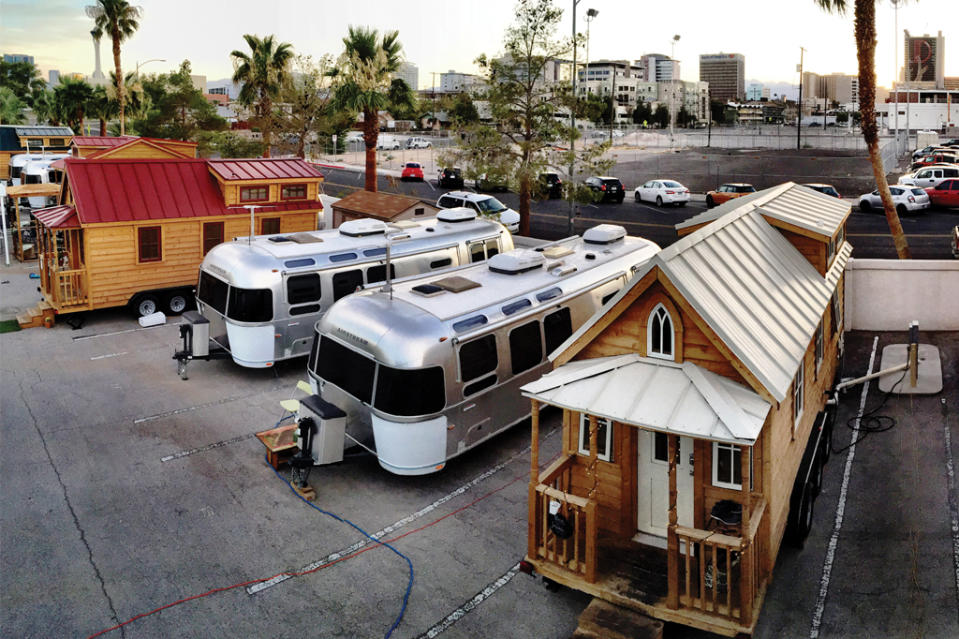
Courtesy of Zappos
Employees admit, though, that the company has matured in its practices over the years. For instance, there are fewer celebratory parades through the offices — and some personal connections have been lost.
Recalled Markel, “When I started in the mid-2000s, we were maybe 300 employees, so it was a much smaller company. I wouldn’t pretend that I knew every single person’s name, but at that point, you really did know a vast majority of the company.”
Now the organization comprises roughly 1,500 employees at its Las Vegas headquarters, and more are being added at a newly opened fulfillment center in Louisville, Ky., and at an L.A. creative hub.
To help foster a sense of belonging, Zappos hosts more than 60 events for the team, for everything from bingo to pizza-eating competitions — and even an Easter-themed Peeps diorama contest.
It also continues to issue license plates to recognize work anniversaries, offers free pet adoptions and organizes an on-site fitness program called ZFit, plus much more.
A sense of community has been part of Zappos’ culture from the very beginning, and Steve Bautista, head of charity and employee engagement, believes these lighthearted shenanigans will help forge even stronger bonds as the business continues to evolve.
“There are moments where there’s so much going on [in our offices], but I think we’re a more efficient company because of the relationships that we have,” he said.

Courtesy of Zappos
Watch FN’s video about how to succeed as a woman in the shoe business:
Want More?
The Experiential Innovations Helping Stores Compete with E-Commerce
Ahead of Its IPO, Uber Is Coming for E-Commerce
These Digital Errors May Have Cost Retailers More Than $60 Million in Holiday Sales
Best of Footwear News
Sign up for FN's Newsletter. For the latest news, follow us on Facebook, Twitter, and Instagram.

